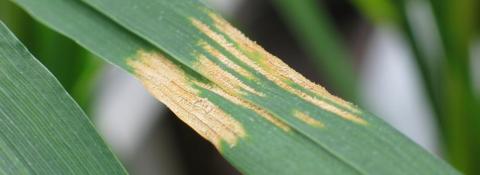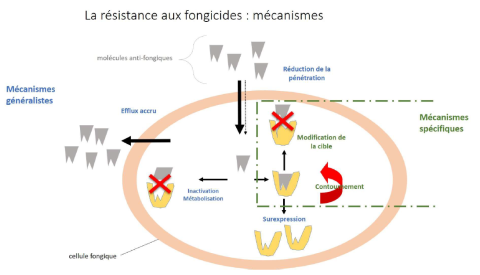
Understanding fungicide resistance in soft wheat
Zymoseptoria tritici is the fungus responsible for wheat septoria, the disease with the greatest economic impact on soft wheat in Western Europe1. Control of this disease is largely based on the application of synthetic fungicides, the use of which has been greatly optimized in recent years to reduce inputs. The effectiveness of these treatments is regularly threatened by the emergence and spread of fungicide-resistant strains. Until now, resistance was specific to a mode of action (targeting the same protein) due to modifications in the target protein, and was therefore "manageable" by applying fungicides with a different mode of action (or target)2. However, for more than 10 years, we have been observing an increase in the frequency of isolates displaying non-specific, non-target-related resistance3. These affect most modes of action, reducing their efficacy and thus undermining dose reduction strategies.
The project aims to identify and characterize new general fungicide resistance mechanisms in the Z. tritici fungus, in order to support the agroecological transition towards reduced use of phytosanitary products (Ecophyto II plan). At current doses, no loss of efficacy of fungicides has been observed in the field, but in a context of reduced use of fungicides, we are facing a risk of reduction or loss of efficacy of synthetic and/or natural antifungal molecules. The same mechanisms could also affect new control methods involving plant defense stimulators.
We have undertaken a massive collection of strains showing non-specific resistance, in 2020 and 2021. In addition, we have hundreds of fungicide-resistant mutants in the laboratory, resulting from experimental evolutionary experiments on different fungicides4 . Characterizing these mutants will enable us to identify new mechanisms that will then be investigated in natural strains. Several mechanisms may be suspected. We have chosen to adopt a process of elimination, starting with the least likely hypothesis.
- Project leader: Anaïs Laleve (BIOGER lab, graduate school Biosphera)
- Project team: Sabine Fillinger, Elza Neau (BIOGER lab), Marjolaine Deschamps, Nathalie Cheviron and Christian Mougin (ECOSYS lab)
- Project start: October 2023. End date: September 2025.
References:
1. Fones and Gurr 2015, Savary, Willocquet et al. 2019
2. Lucas, Hawkins et al. 2015
3. Garnault, Duplaix et al. 2019, Hu and Chen 2021
4. Ballu, Deredec et al. 2021, Ballu, Despreaux et al. 2023

